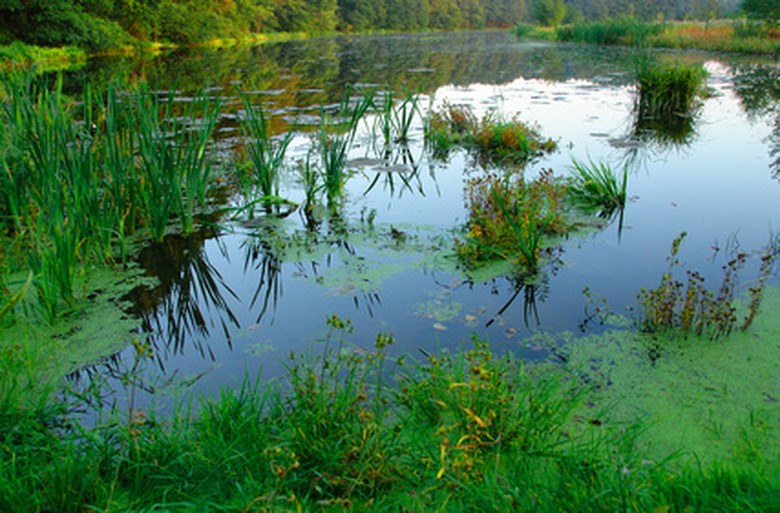How To Make A Pond Diorama
Creating a diorama of a pond presents an opportunity to learn about the local ecosystem. A pond may contain fish, frogs, turtles, alligators, snakes, beaver or a variety of other local wildlife as determined by the geographic location. Plants will vary from region to region depending on temperature, season and weather patterns. Research the local ecosystem before beginning the diorama to determine what items should be included.
Step 1
Determine what animals to include in the diorama. For this example a frog, several fish and a turtle will be used. Lay the shoebox on its side. Draw circles on the side facing up. The circles should not be more than 2 inches across if the scale is 1 inch = 1 foot. These will be the lillypads on the pond. Mix the green and blue paint together in the pie tin to create an aqua color. Paint the entire inside of the box with this color. Paint the circles on the top green. Allow the paint to dry.
Step 2
Determine the scale of the diorama. For this example 1 inch = 1 foot. Determine the type of fish to make. In this example Walleye, Trout and Bass will be used. Set the white paper down on a flat surface. Trace or draw three fish bodies. A Largemouth Bass is approximately 1 ½ feet long so the model should be 1 ½ inches long. Walleye are commonly 2 feet long so the model should be 2 inches long. Lake Trout can be as long as 2 ½ feet so the model should be 2 ½ inches long. Color the fish on both sides to represent the species. Make additional fish if desired.
Step 3
Create the bottom of the pond first. Set the box on its side with the circles facing up. Mix glue with dirt in equal parts. Start with ½ cup of each and spread the mixture on the bottom of the pond. Add more as necessary to cover the entire bottom. Add small sticks lying horizontally on the bottom to represent fallen trees. Sticks should not be more than 6 inches long. Place a few small rocks together on the bottom and glue in place. Place large objects toward the back of box.
Step 4
Determine what depth the fish are normally found swimming. Lake trout tend to swim at the bottom of the lake, Walleye swim towards the top of the lake when feeding, Bass gather around rocky bottoms. Cut a section of clear fishing line at least 6 inches long for each fish. Tape one end of the line to the body of the fish. Adjust the other end of the line on the inside top of the diorama so the fish hangs at the appropriate depth. Tape the line to hold the fish in place and cut the excess line off. Place the frog on top of the diorama on one of the lilly pads. Glue in place. Place the turtle on one of the sunken logs inside the box and glue in place.
Things Needed
- Shoebox
- Pencil
- Green paint
- Blue paint
- Pie tin
- Paintbrush
- White paper
- Scissors
- Markers
- Glue
- Dirt
- Sticks
- Pebbles
- Clear fishing line
- Clear tape
TL;DR (Too Long; Didn't Read)
Start the diorama from the back and move forward. Place large objects toward the back of the diorama. Use local items such as grasses, pebbles or sticks whenever possible.
References
Cite This Article
MLA
Marcotte, Dawn. "How To Make A Pond Diorama" sciencing.com, https://www.sciencing.com/make-pond-diorama-6352436/. 22 November 2019.
APA
Marcotte, Dawn. (2019, November 22). How To Make A Pond Diorama. sciencing.com. Retrieved from https://www.sciencing.com/make-pond-diorama-6352436/
Chicago
Marcotte, Dawn. How To Make A Pond Diorama last modified March 24, 2022. https://www.sciencing.com/make-pond-diorama-6352436/
